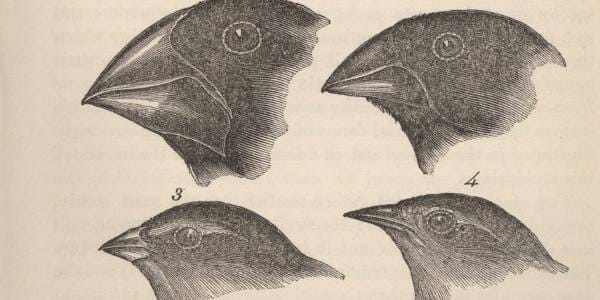
February 12 is Darwin Day, the birthday of the brilliant author of On The Origin of Species. This year marks the 200th anniversary of Charles Darwin’s birth, which nature lovers everywhere should celebrate joyously. We find reasons to praise Darwin on this blog all the time and explain why in this post, first published in 2009.
The name of this humble website is based on a round number, a very round one indeed considering the shape of all those zeroes. 10,000 is the approximate number of bird species in the world but certainly not the actual number. If I understand correctly, the known number of avian species lies somewhere south of 10,000, yet scientists believe that when all is said and done, once the lumping, splitting, and searching is complete, we may have named 12,000, 13,000, or even more. Of course this calculus does not consider how many species are teetering on the brink of extinction or how global warming promises to make survival difficult for ecological specialists of any and every stripe.
10,000 is ultimately a useful estimate that ignores the ebb and flow of conditions on the ground. The truth is that, as far as the actual number of bird species living in our wide world right now, sometimes we have bad days when we lose a bird forever. Sometimes we have good days where we discover a long-lost friend or a brand-new one. The delight we all share in the discovery of new species highlights the hidden connection between birding and evolutionary theory.
Birders are consumers of the fruits of evolution, celebrants of the processes of natural selection and genetic drift. It may be fair to say that birding has deeper ties to evolutionary theory than any other recreational activity in the world. Whether we realize it or not, those of us who track changes in avian taxonomy for year to year, who care about splits in scrub-jays or Empidonax flycatchers, are end-users of the very biological processes that inspire so much controversy and confusion.
On Speciation
Speciation is an evolutionary process. The biologist David Haig explains, “Speciation comes about when there is recombination and isolation between different groups of genes, so that no longer can genes in one group be recombined with genes in another group.” What this means is that one species, for example a Stripe-headed Tanager, exists at a point in time as a distinct set of interbreeding organisms. Every member of this gene pool is recognized as a stripe-headed tanager. These tanagers breed only with each other, eschewing the company of parrots, warblers, and even other groups of tanagers, some of which are really, really beautiful. (Let’s not get into hybridization, which only complicates the point!)
Now, imagine that some genetic variant, say a longer beak, spreads through part of the pool as a result of factors like natural selection and that birds possessing this variant mate only with other birds with the variant. This can happen for a number of reasons. In the case of our tanager, groups of birds found themselves separated over time on different Caribbean islands. Distinct species evolved out of these geographically isolated populations. Through the process of allopatric speciation, one stripe-headed tanager became four different species: Western Spindalis, Puerto Rican Spindalis, Jamaican Spindalis, and Hispaniolan Spindalis. Now that they’re different species, it is assumed that, even if, say, the Puerto-rican and Jamiacan Spindalis came together, they wouldn’t interbreed. (If the likelihood was that if these distinct populations ever occupied the same territory again and would interbreed, resulting down the road in a single homogeneous population, they would only be considered subspecies, not species.)
New species may also develop in the same geographic area at points where ecosystems diverge or possibly even in the same ecosystems. Distinct gene pools form and one species becomes two, three, or many, many more. Where once we recognized the Solitary Vireo, we now acknowledge Blue-headed, Plumbeous, and Cassin’s Vireos. Good news for champions of biodiversity as well as those of us eager to inflate our life lists.
Birding and Biodiversity
There is much more to the story of speciation, though even the brief overview above might be more scientific than many nature lovers would like. Why speciation is controversial is beyond me, but how it can serve as the foundation of an endlessly fascinating preoccupation with different lifeforms has become much more understandable as my experience in watching birds, insects, and a wider and wider range of lifeforms increases.
Let others explain why Lesser and Greater Scaup look so similar or how the Mallard’s dominant genes threaten the integrity of related duck species. I’m just amazed every time I successfully distinguish between Anas platyrhynchos and A. rubripes or observe how the relationship between species and ecosystem is far more reciprocal than it might seem on the surface.
Charles Darwin was an earnest, passionate naturalist and scientist. He was also, in a manner of speaking, the original nature blogger. A fitting way for anyone to celebrate Darwin Day would be to go out and count a bunch of bird ( or tree, fish, etc.) species. Judgments of fitness are not necessary! (You might also want to check out the Blog for Darwin between Feb. 12-15 for links to exceptional Darwin-related content.)











That was beautiful.
I like the idea of birders as end-users of evolution. I agree that evolution is a beautiful, beautiful thing. The more I learn about it, the more amazed and awed I am. To me, it is a much more satisfying, wondrous, mysterious, and gorgeous explanation than creationism is.
great post Mike
Wonderful post . . happy birthday Chuck!
Yet another beautifully written post!
Kudos to you.
I LOVE the “original nature blogger” connection – it’s so true!
Wonderful post!